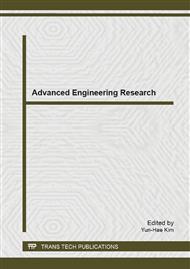p.68
p.72
p.76
p.82
p.86
p.90
p.94
p.98
p.103
The Engineering Application of New Method for Calculating Seismic Active Earth Pressure of Soil-Nailing Retaining Structures
Abstract:
Based on the method for calculating seismic active earth pressure of soil-nailing retaining structures literature [ , the effect of horizontal seismic coefficient on seismic active earth pressure and the most dangerous sliding are analyzed in connection with practical engineering projects, and compared with the result which is not considered the seismic action. Results show that The existence of soil nails can effectively reduce the lateral pressure of supporting structures under earthquake ground motions and make the sliding surface slowly move to the wall back; Increased along with the height of soil nailing wall;With the increase of the height of soil nailing wall ,facing wall the sliding movement amplitude increase under the action of earthquake, and the soil nail length is growing.
Info:
Periodical:
Pages:
86-89
Citation:
Online since:
April 2014
Authors:
Price:
Сopyright:
© 2014 Trans Tech Publications Ltd. All Rights Reserved
Share:
Citation:


